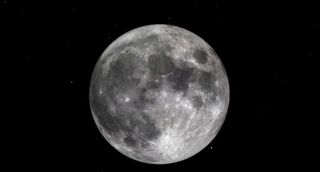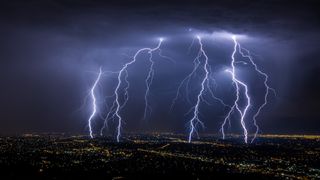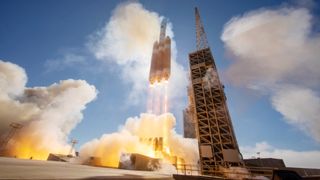Explore the moon like never before with All About Space magazine
Even though we know more about our natural satellite than any other celestial body — and have even visited it — the moon continues to fascinate us.

Inside All About Space issue 135, on sale now, take an in-depth look at our nearest neighbor with All About Space's complete guide to the moon.
Learn more about how the moon formed and discover the similarities between our home planet and our rocky companion. Take a lunar world tour and explore iconic locations that have featured in missions such as Surveyor 1 and Apollo 11.
The latest issue also includes a Q&A feature with Astronomer Royal Martin Rees about his contributions to the Big Bang theory and life on other planets.
Related: How to photograph the moon using a camera: techniques, kit, and settings

Get All About Space delivered straight to your door or digital device. Subscribe to All About Space from $8.50 per quarter/three issues.
Elsewhere in the issue, you can find out how the biggest stars in the universe — cosmic monsters up to a million times brighter than the sun — supergiant and hypergiant stars, push the limits of astrophysics.
All About Space also takes an electrifying look at lightning superbolts. They're 1,000 times more powerful than typical lightning, yet scientists still don't fully understand how they pack such a punch.
The latest issue also investigates the feasibility and practicality of 3D printing moon bases, rockets and even food to facilitate lunar settlement.
Get the Space.com Newsletter
Breaking space news, the latest updates on rocket launches, skywatching events and more!






You can also find a detailed stargazer section filled with useful information on what to look out for in the night sky. This issue also includes 15 tips you need to be a better astronomer, from planning ahead to improving your observing skills, and learning how to make your time outside with the night sky more efficient and enjoyable.
Complete guide to the moon

Because we can easily discern features on the moon with the naked eye, it's been a source of wonder to us since ancient times. The moon is the brightest object in our sky after the sun and influences everything from our oceans to our calendars. It's always been 'the moon' because we didn't know that there were any others. Once Galileo discovered in 1610 that Jupiter had satellites, we've used the word 'moon' to describe celestial bodies that orbit larger bodies, which orbit stars. Since the moon has always been so present it might not seem worth studying, yet there's a reason why we continue to return to it — we still have plenty to learn from our satellite.
Read the full feature in the latest All About Space.
What causes lightning superbolts?

Lightning strikes are something to fear. Around 2,000 people are killed by them each year, and aside from causing many more injuries, lightning has the power to destroy objects too. But there's a type of lightning you wouldn't want to encounter. Called superbolts, they don't happen all that often, "yet they're 1,000 times more powerful than typical lightning," says Jean-Francois Ripoll, senior scientist at the Commissariat à l'Énergie Atomique (CEA) in Paris. "Superbolts are also potentially very destructive." But their cause and nature remain unknown decades after being discovered.
Read the full feature in the latest All About Space.
Space factories

Every kilogram that must be hauled into space for a human crew represents one kilogram less that can be used for science experiments or instrumentation. More capable rockets is one solution to this problem. But what about actually making the components and food you need on site? The idea isn't as far-fetched as it sounds. The European Space Agency (ESA), NASA and others are testing out 3D printing as a way to manufacture structures, rocket parts and even pizza. Looking ahead, the ESA has suggested that 3D printing could reduce the cost and complication of future lunar bases. "3D printing offers a potential means of facilitating lunar settlement with reduced logistics from Earth," said Scott Hovland, head of the Facilities and Technology Unit at the ESA. The first step is to find a structure that works.
Read the full feature in the latest All About Space.
Join our Space Forums to keep talking space on the latest missions, night sky and more! And if you have a news tip, correction or comment, let us know at: community@space.com.

Daisy Dobrijevic joined Space.com in February 2022 having previously worked for our sister publication All About Space magazine as a staff writer. Before joining us, Daisy completed an editorial internship with the BBC Sky at Night Magazine and worked at the National Space Centre in Leicester, U.K., where she enjoyed communicating space science to the public. In 2021, Daisy completed a PhD in plant physiology and also holds a Master's in Environmental Science, she is currently based in Nottingham, U.K. Daisy is passionate about all things space, with a penchant for solar activity and space weather. She has a strong interest in astrotourism and loves nothing more than a good northern lights chase!